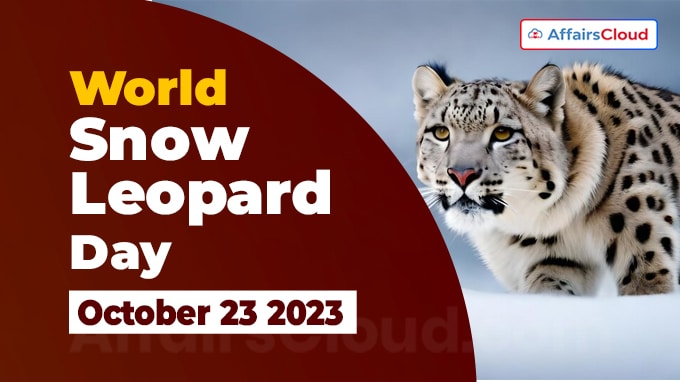 World Snow Leopard Day, also known as International Snow Leopard Day, is annually observed across the globe on 23 October to raise awareness about the conservation and protection of Snow Leopard, one of the world’s most elusive and endangered big cats, and their natural habitat.
World Snow Leopard Day, also known as International Snow Leopard Day, is annually observed across the globe on 23 October to raise awareness about the conservation and protection of Snow Leopard, one of the world’s most elusive and endangered big cats, and their natural habitat.
- The Snow Leopard (Panthera uncia) are listed as Vulnerable by the International Union for Conservation of Nature (IUCN) Red List of Threatened Species.
Significance:
The Day commemorates the adoption of the ‘Bishkek Declaration,’ as well as the Global Snow Leopard and Ecosystem Protection (GSLEP) Program, by all snow leopard range countries on 23 October 2013, in Bishkek, Kyrgyzstan.
Background:
i.During the Global Snow Leopard Conservation Forum in Bishkek, Kyrgyz Republic, from 22-23 October 2013, the 12 snow Leopard range countries adopted the Bishkek Declaration on the Conservation of the Snow Leopard and declared the 23 October of every year as the International Snow Leopard Day.
- With the adoption of this declaration, the Snow Leopard Range Countries endorsed a comprehensive, long-term GSLEP Program
ii.The first-ever International Snow Leopard Day was observed on 23 October 2014.
Bishkek Declaration:
The Bishkek Declaration emphasises the commitment of Snow Leopard Range Countries. It focuses on creating thriving ecosystems for both snow leopards and the local communities.
- The declaration aims to contribute to the prosperity of nations and the planet.
Note: The Bishkek Declaration also declared the year 2015 as the International Year of the Snow Leopard.
12 Snow Leopard Range Countries: Afghanistan, Bhutan, China, India, Kazakhstan, Kyrgyz Republic (Kyrgyzstan), Mongolia, Nepal, Pakistan, Russia, Tajikistan, and Uzbekistan.
Global Snow Leopard and Ecosystem Protection (GSLEP) Program:
GSLEP is an unprecedented alliance of all snow leopard range countries that aims to save snow leopard and their habitat and to identify and secure at least 20 snow leopard landscapes across the cat’s range by 2020.
- The snow leopard range countries have identified a total of 24 landscapes to be secured for snow leopards
Key Facts:
i.Snow leopards live in high alpine areas, mostly above the tree line and up to 18,000 feet in elevation. It is estimated that around 4,080-6,590 snow leopards are in the wild.
ii.The estimated size of the snow leopard’s distributional range is about 1.8 million square kilometers, with the largest share in the Tibetan plateau of China, followed by Mongolia and India.
Snow Leopards in India:
i.There are about 500 individuals in the higher reaches of Indian Himalaya.
ii.In India, Snow leopards are Snow leopards due to poaching for its pelt and body parts, a decline in prey base (mostly Blue Sheep and Asiatic Ibex) and and retaliatory killings by village communities.




